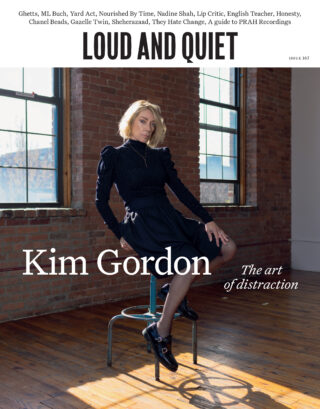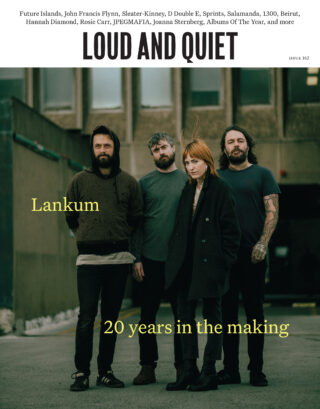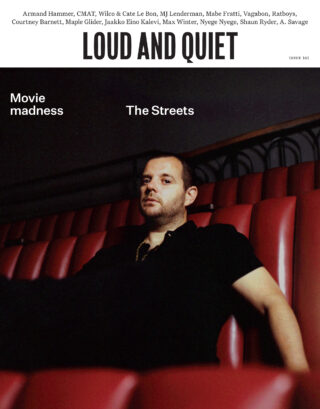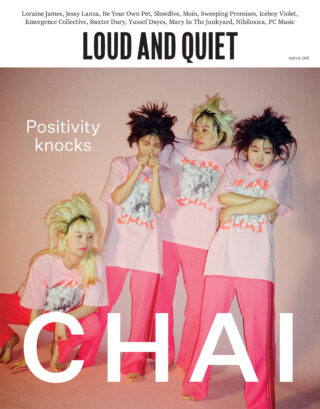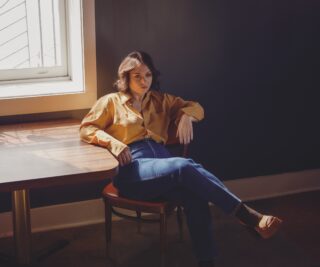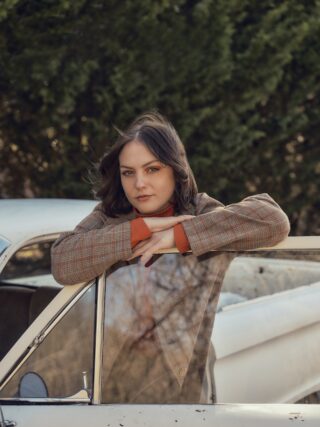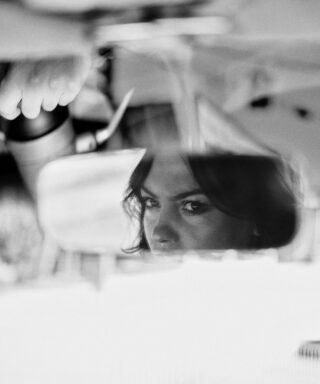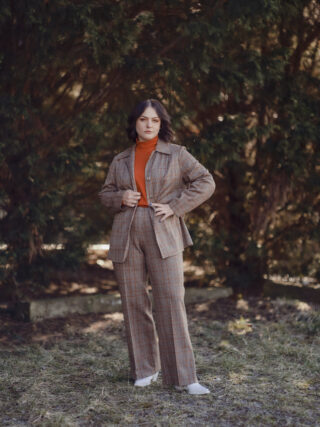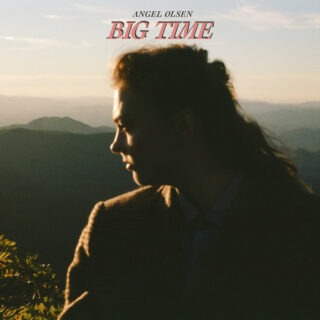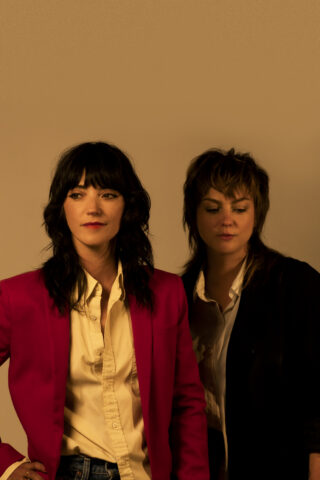It’s raining in downtown Asheville. The weather hangs close in mountain towns, and today a low fog hovers around the buildings, casting a hazy damp grey on everything for miles around. On days like this, Olsen likes to drive. That’s our plan today – she’ll drive us around the Blue Ridge Mountains, showing me around as she tells me about her new album and everything that shaped it.
I’m surprised. Now on the cusp of her sixth full-length, Olsen is a veteran of the music industry who is all too familiar with the rigamarole of a press rollout and music journo bullshit. She has suffered through enough pat and reductive questions about “being a female songwriter” for a lifetime, she has seen the flattening effect a profile can have on her work and her identity.
Yet here she is, welcoming me into her passenger seat for the day. Despite some palpable (and fair) scepticism about the press, she’s talkative, friendly and much more at ease than you would expect from someone about to talk about a deeply personal album with a stranger for seven hours. Experience plays in here – this isn’t Olsen’s first rodeo – but part of it is also a newfound level of comfort and confidence in her music and personal life, which she’ll discuss at length over the course of the day. Another part of it is just being home. Olsen clearly loves Asheville. She jokes with friends that one day she’ll become a tour guide.
She’d be good at it. Whipping through the mountains, she points out the river running along the road. “That’s the French Broad. It’s one of the oldest rivers in the world.” So old, I later learn, that it’s impossible to say quite how old it is, though geologists ballpark it at 325 million years. In much more recent history, Asheville has made a name for itself through its outsized cultural footprint. The area has been a fertile creative home to several artists, writers, and musicians throughout the 20th century. Thomas Wolfe and the Fitzgeralds spent time here, and the influential art school Black Mountain College, where artists like Ruth Asawa, John Cage and the Albers taught, is just 20 minutes from downtown. Today Asheville is home to globally-known artists like Olsen and the genre-bending Moses Sumney, the storied venue the Orange Peel, and a vibrant local scene. Rolling Stone called it “the new must-visit music city” a few years back.

Olsen moved here back in 2013, just before the release of Burn Your Fire for No Witness. That album, her second, was arguably her first big break; a critically acclaimed record of lo-fi tunes that drew comparisons to Leonard Cohen’s work and landed on plenty of year-end lists. Her arrival in Asheville roughly coincided with the takeoff of her solo career.
But before that, she cut her teeth in the Midwest. She’s originally from St. Louis, where she grew up as the youngest of nine in a blended family. Olsen is adopted and her parents both brought children from previous relationships. “Everyone had a different set of parents,” she notes. “My mom wasn’t the mom of everyone, my dad wasn’t everyone’s dad.” Olsen remembers her childhood as loud, with raised voices and the TV on. A household of 11 generates some serious volume.
“My dad used to be a big yeller,” she recalls. “[He] was a hard guy, but he softened over the years.” She was closer with her mother. “My mother was the most hilarious. You never knew what she would say next but it would always crack you up. If ever I’m funny, I have to give her credit for that.” Olsen, for the record, is indeed quite funny, albeit in a particularly dry way. “My family was religious, but like Baptist religious, and I wasn’t,” she says. “I tried for a little bit but I can’t. I simply don’t care for congregating. Or listening to white old dudes tell me how I should connect with God. It’s just not cute.” It comes through in her lyrics, too. On the new song ‘Right Now’, she belts out a wholehearted chorus of “Why’d you have to go and make it weird?” I tell Olsen this made me laugh and she replies with a muted smile, “It’s not your typical country classic.”
Eventually she moved to Chicago to break out of St. Louis’s orbit. Her music career began there, writing and playing in the city’s scene and, eventually, singing backup vocals with Bonnie ‘Prince’ Billy. ‘Dream Thing’, a song on the new album, is a slight nod to those years inspired by, you guessed it, a dream Olsen had. “I was searching my mind for the words to that ‘Black Captain’ song,” she sings, “I was looking at old you, looking at who you’ve become.” I point this connection out and I suspect that Olsen, watching the road, is rolling her eyes. She gets a lot of questions about this relatively short period of her life from over a decade ago – are we still talking about this, although, in my defence, the reference on the new album makes it difficult to ignore. That chapter of Olsen’s career ended after she toured her first album, Half Way Home, and moved to Asheville, determined to step out on her own. She left glad for the opportunity but equally grateful to be “out from under the hetero, patriarchal, brooding indie rock dude bullshit” that characterized her early experience of the music industry (she makes a point to note that while this is something from which she’s mostly broken free from in her career, it remains a real problem for many).
Asheville proved itself to be a necessary haven for Olsen after that first move, and since then she’s returned there between albums and tour dates to reset and recharge. It’s a good town for that. Incredible hiking, friendly people and a comically robust healing economy (throw a stone and you will hit an acupuncturist, herbalist or Transcendental Meditation centre). But because of her career, Asheville was always a place she came back to rather than somewhere she lived. She has estimated that she spent nine months on the road per year. Then, like everyone else in the world, she was suddenly spending way more time at home.
Over the course of the pandemic, her fans were spoiled with new music. She released Whole New Mess, an album’s worth of material recorded in a studio/haunted church in Anacortes, Washington (pared down versions of the songs that originally inspired 2019’s All Mirrors), a deluxe combined version of those two albums called Song of the Lark and Other Far Memories, complete with bonus tracks and remixes, and an EP of synthy covers of ’80s hits called Aisles. She dropped an absolute banger of a single with Sharon Van Etten, ‘Like I Used To’, which will undoubtedly bring down the house when the two hit the road with Julien Baker later this year. (Van Etten is “the real thing,” Olsen tells me; hers is the first name she mentions when we discuss rare examples of true integrity in the music industry.) Throughout, she live-streamed shows and shared covers on Instagram. Even though the world stopped, Olsen’s music kept coming.
All the while, she was going through a separate process of self-discovery and struggle, coming to terms with her sexuality and confronting the illness of her ageing parents. “I was dealing with a breakup and sorting through the feelings of my first queer relationship,” she says. “And during that relationship, I wasn’t ready to come out. Everyone needs their own time to do that, and because my parents were so sick, I didn’t know how, or when.”
That relationship and its end had a profound effect on her. “That was the first time I was really being open with myself,” she says. “In previous relationships I had hidden myself, I didn’t allow people in in the same way.” In the aftermath, she had to reckon with a new sense of identity. She started exploring her neighbourhood and beyond, taking long walks and absorbing whatever the world cared to offer. “I like the things, even when I’m heartbroken, that open up to me when I’m alone,” she says. Mostly, she took her time. “Sometimes the hourglass is the best healer.”
Then, in late 2020, she met her current partner – also a writer, who, at the time, was doing a writing residency in Asheville. When Olsen talks about them, she relaxes. “When we met, we had a long hug and it was like, ‘Oh God, I feel high.’” It wasn’t long before the two moved in together.
“I’m very in love,” she says. You can tell. As we drive around she occasionally gives off that casual Zen you find in those friends who are holding it down in good, stable relationships. Olsen’s partner is responsible for that in a major way – she says they balance out her more serious, cynical tendencies. The personal growth on Olsen’s end in the months and years preceding also played a role. “I feel more comfortable being myself, I can offer a lot more.” And then there’s the fact that in a relatively short period these two have weathered a brutal time together.
With a newfound confidence in herself and her relationship, Olsen felt ready to come out to her parents and the world (she identifies as queer). She told her mom last spring. Three days later, her father died. Her mother’s condition rapidly worsened, and she passed away soon after. Her partner met her family for the first time at her father’s memorial, and they sat at her mother’s bedside in the hospice.
Olsen’s parents were already fairly old when they adopted her; their health had been in decline for some time. In some way, she felt it coming. “[New track] ‘Through the Fires’ was written before my mom died, but sometimes when I write things, it feels prophetic,” she says. “It sounds stupid, but you feel it – the impending loss.” Expected or not, death in the family is awful. Grief does not respond to preparation.
“We never got to talk more about it, but I’m glad I told her,” Olsen says of coming out, and she feels relieved that her mom met her partner. “They’ve really been there for me during all of this stuff in a way that was really sweet and really special.”
Does this feel like a jam-packed, laundry list account? A long narration of Major Life Events? It does because it is, and it is because there’s really no other way to tell it. In a few months’ time, Olsen came out, lost her father, introduced her partner to her family, and lost her mother. It was a hell of a lot.
Then three weeks later, she flew to Los Angeles to record a new album.
